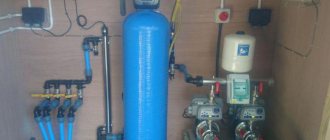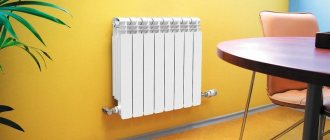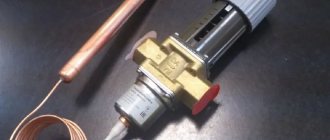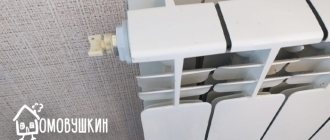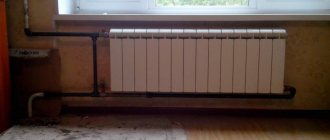How to get rid of an air lock in a water supply?
To get rid of air locks in the plumbing system, you need to install an automatic air bleeder on the pipe; it will independently remove air from the pipe or install a mechanical valve, valve or ball valve. Air regulators are cylindrical in shape with a flat top.
Interesting materials:
How to respond to a job refusal? How is term paper printed? How to switch to standard desktop in Windows 8? How to switch between desktops? How to move desktop in Windows 10? How to transfer photos from classmates to your desktop? How to transfer Google Chrome to desktop? How can I move my desktop to another drive? How to stop being distracted and start working? How to convert working days to calendar days when calculating vacation pay?
When to drain water from batteries
Sometimes maintenance is not the only reason for draining the coolant. Sometimes this needs to be done during renovation work. For example, it is necessary to replace the radiator in a room. There are battery models where shut-off valves prevent the water from being drained. But if it is necessary to replace a cast-iron radiator with a modern metal section, then drainage is necessary.
It is necessary to drain the liquid while cleaning the system from limescale. Often the cause of blocked pipes is rust build-up on the internal surfaces of the pipes if they are made of metal.
How to bleed air from radiators
See if the Mayevsky valve - an air vent - is installed on the battery. The tap is installed on one of the connecting threaded flanges. This makes it easier to release accumulated air. In other cases, more effort will be required.
How to remove air through a faucet
Mayevsky taps, or air valves, are installed in apartment buildings instead of shut-off and control valves. This design allows air to bleed and water to drain. The faucet is a plug with a head on which there is a hole or groove. In the middle there is a tap for a slotted screwdriver. The most convenient designs are equipped with a rotary key.
The procedure is as follows:
- Turn the faucet. After several revolutions, the air will begin to bleed out with a hiss, and later a mixture of gas and coolant will flow. The liquid needs to be drained. Do not twist too much, otherwise the media, which emerges under high pressure, will splash the walls, floor and furniture.
- A fair amount of water will have to be released. In a high-rise building you will need to release 20–30 liters, that is, two or three buckets. In a private house you don’t need to drain so much - just wait until the liquid flows in an even, non-bubbling stream. After this, you can screw the tap back on.
If you don’t want to constantly bleed, buy and install an automated valve. Its price is low. But remember that automation sometimes malfunctions, so heating requires control. The automatic valve allows, if necessary, to manually release the air plug.
How to remove air without a tap
If there is no tap or valve on the radiator, you will have to bleed off the gas-air mixture through a plug. This is a flat element mounted on tow, which is located on the opposite side of the input. In old houses it is often painted over with several layers of paint and is difficult to see.
If it is not possible to isolate the room from the general house heating system, close the common riser before starting work. Otherwise there will be a flood.
You will need:
- Adjustable wrench.
- Paint thinner.
- Bucket or basin for draining water.
- Tow
First of all, soften the paint on the plug with a solvent so that you can unscrew it. Remove the element with an adjustable wrench. But even after the paint softens, the plug is unscrewed with great difficulty. Therefore, you will have to make an effort. Turn the key slowly and carefully until you hear the sound of air escaping. Bleed it and drain about three buckets of coolant. There is tow wound under the plug - replace it with a new one. Then screw everything into place.
Ventilating the heating system in this way is quite troublesome. Therefore, old radiators are now being replaced en masse with new models that are more convenient to use.
How to drain water from radiators without a drain valve
Is there no drain fitting on the radiator? This is a solvable issue. Heating appliances left over from Soviet times very often do not have shut-off valves or drain valves. This complicates the work, but makes it more interesting :)). Brief guide to action:
Step 1: Turn off the water supply . Before starting work, turn off the liquid supply to the heating devices. Next, you need to wait until the coolant cools down completely. Before starting the draining process, turn off the system and wait until the pipes and radiators have cooled completely. If you have a gas or combination boiler, drain the liquid from the expansion tank.
Step 2. Isolate the radiator from the heating system . When draining central heating without a drain valve, it is necessary to separate the coolant in the battery from the system. This requires closing two valves. The valve must be rotated clockwise.
Step 3: Open the air valves at the top . It is necessary to open the bleed valves to release air into the system, this will speed up the draining process.
Step 4: Loosen the union nuts and begin draining the fluid. The way you drain a central heating system without a drain valve should look something like this:
1. Unscrew the connecting nut from the radiator side.
2. Place a bucket under it and put some old rags under it, and keep an absorbent towel handy.
3. Using a wrench, turn the nut counterclockwise until water begins to flow into the bucket.
How long does it take to drain water from a radiator? The liquid flows by gravity and, depending on the volume of circulating coolant, it may take 20 minutes. On average for a one-room apartment – 15-20 minutes. For a house with an area of 200 square meters, drying heating appliances takes about 1 hour.
Step 5: Attach the hose and drain the heating system. While the radiator valve is in the closed position, attach a hose to it and begin draining the central heating system. To do this, you will need a special fitting to attach the hose itself. Once the radiator is empty, carefully remove it from the wall, as the water in it can stain the walls. To prevent this, make sure that both valves (top and bottom) of the battery are tightly tightened.
It is worth noting that a battery filled with liquid is not light in weight. To remove it from the main pipeline, physical strength and 2 pairs of male hands may be required. Although, as Nekrasov wrote: “There are still women in Russian villages.”
How to drain water from batteries with a shut-off valve
A heating system is integrally present in every apartment. The owner of the house simply must have basic knowledge of network maintenance. If an emergency situation occurs, for example a pipe burst, knowledge in this area will help avoid an accident.
Step 1: Turn off the water supply. Before you start draining, you must stop the circulation of coolant in the system. Then wait until the pipes have cooled completely. If you are going to replace or restore radiators, let them cool down too. If an autonomous shut-off valve is not provided in your home, then the water can be drained only after the end of the heating season. In the event of an accident, special services staff shut off the entire heating riser.
Step 2. Turn off the boiler, if provided . If the boiler in the house runs on solid fuel, it is better to put out the fire and wait until the boiler has cooled completely. If the boiler is electric, turn off the nozzles completely and remove the plug from the socket. In the case of central heating, this point is not relevant.
Step 3. Turn off the water supply to the boiler . Before draining the heating system, stop the water supply to the heating unit, which will prevent liquid from entering it during operation. For this purpose, a separate shut-off valve must be installed.
Depending on the model of the device, manufacturers indicate in the instructions how to properly drain water from the boiler. Be sure to read the manual before performing work.
Step 4: Find the correct radiator with drain valve. If you live in an apartment or house with two levels, then the necessary radiator is always located on the ground floor. The drain fittings are located either on the radiator itself from below or on a suitable pipe. The valve must be equipped with a hose or flexible tube attachment. Place one end on the tap, and lower the other end into a drainage container (bucket or basin). If necessary, tighten the hose with clamps or just wire so that it does not get knocked out by water pressure.
Step 5: Start draining the radiators. Now it's time for the real work. Open the outlet valve to allow water to flow out freely. To make the liquid flow faster, just open the tap a full turn. If the radiator is equipped with a drain hole at the top, then open it, this will increase the water pressure.
The liquid drained from the heating has an unpleasant rusty tint. Often the water turns into a cloudy slurry if the inspection has not been carried out for a long time. Drain the coolant exclusively into the sewer. The best option would be to dispose of it in the toilet, since the water in the centralized heating system contains chemicals that can cause illness if it comes into contact with the skin and mucous membranes.
Sometimes a certain amount of air enters the system, which impedes the movement of water. If this happens, you can organize a return flow of fluid into the radiator and knock out the air plug. It's easy to do. Attach the return end of the hose to a cold water faucet and run a pressurized stream back into the heater. This should help get rid of the airy area.
Step 6. Check for lack of coolant. Make sure all radiator valves in your home are open and double check if necessary. The draining process takes from 20 minutes to an hour, depending on the volume and type of heating.
If the coolant at the outlet had a rusty and cloudy sediment, it would be a good idea to rinse each radiator separately. Do this using water pressure from a cold tap.
Step 7: Refill the system . After completing the installation of heating radiators or carrying out repair work, it is necessary to refill the batteries. It is important to prevent the formation of air-filled areas. Start by closing any valves you previously opened, and also close the drain valve on the radiator. After filling the entire system, fill the heating boiler (if equipped) with liquid. As soon as the pressure rises to operating values, begin pumping the radiators from below. Then repeat pumping from above. This way all the air is expelled and the tightness is checked.
It is possible to check the quality of operation of radiators in a centralized system only with the onset of the heating season. For residential premises with an independent heating method, the check can be performed at any time.
We recommend adding special inhibitors to the water to slow down the corrosion process. But their use is only suitable for closed heating circuits. This method is not applicable for central heating batteries with main supply.
Why are batteries purged?
Flushing is needed to clean pipes and batteries from various deposits that accumulate in the system during its operation. It's all due to impurities in the water. For normal operation of the in-house heating system, it must be flushed every year. Then the radiators will heat normally.
Interesting materials:
How long does it take to cook fish for fish soup? How long should you cook beets in a pressure cooker? How long do you need to soak milk mushrooms? How long does it take to bake a cake? How long does it take to brew herbs? How long do financial pyramids usually last? How long does it take for bread to cool? How long does it take to open an individual entrepreneur? How long does it take to open a bank account? How long did the first artificial satellite spend in space?

